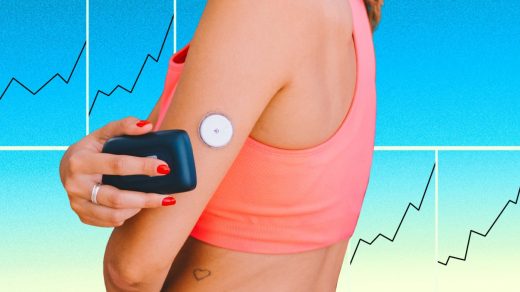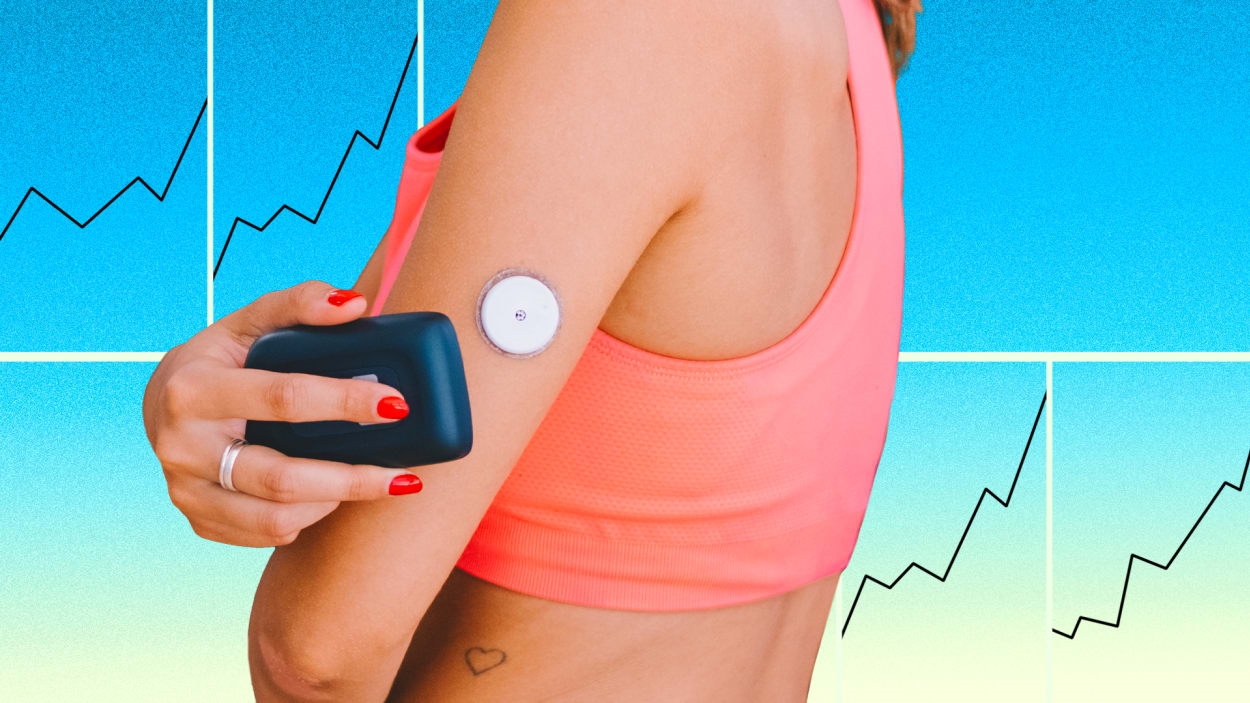These devices changed the game for diabetics. Now they’re the latest wellness trend
By Ashwin Rodrigues
“This small thing . . . is the next big thing in diabetes,” Nick Jonas explained at the beginning of an $7 million commercial that aired during the Super Bowl. He was referring to a sensor for the new Dexcom G7 continuous glucose monitor.
Jonas knows what he’s talking about. He has Type 1 diabetes. But viewers didn’t need to take his word for it. A couple of weeks after that ad ran, Bloomberg broke the news that Apple has been working on a “moonshot” project involving a “no-prick” method of continuous glucose monitoring, with hundreds of millions of dollars already spent on the initiative that started under Steve Jobs.
The timing couldn’t be better for either company: The market for CGMs has been growing for years. As the devices continue to become easier to use and more discreet, fitness enthusiasts without diabetes have begun clamoring for them, believing that being hyperaware of their blood sugar levels can help them unlock new insights about their body and mind. Meanwhile, a handful of health and wellness startups are working to get the technology developed by stalwarts like Dexcom and Abbott into the hands—or arms—of consumers without diabetes, promising everything from weight loss to bonk avoidance (more on that later).
What is a continuous glucose monitor?
For the roughly 11% of the American population that has diabetes, and those who know them, the continuous glucose monitor is a familiar sight. It’s a tiny sensor that is typically “worn” on the user’s upper arm, and must be replaced every week or two. A portion of the sensor reaches under the skin and constantly measures interstitial glucose levels—in the fluid around the cells—and relays that information to a handheld device and/or mobile app.
The first CGM, introduced in 1999, was roughly the size of a handheld cassette player (if that’s still a useful size metric). Since then, CGMs have become more accurate and smaller, with some sensors the size of “two pennies stacked together,” says Marc Taub, divisional vice president of technical operations for the diabetes business at Abbott, one of the most prominent CGM producers in the world.
Using a CGM, the wearer can avoid periods of hyperglycemia (blood sugar above standard range) and hypoglycemia (blood sugar below standard range). When a wearer’s levels go out of range, they receive alerts, which may prompt them to administer insulin or go for a walk when glucose levels too high, or to eat a snack if blood sugar levels are dropping.
For people with both Type 1 diabetes (early onset; patients produce no insulin) and Type 2 diabetes (develops later in life; patients continue to produce some insulin), advancement in CGM technology has been a game-changer. The problem is access and affordability.
Most patients can only procure a CGM if it’s covered by their insurance plan and, even then, it can cost thousands of dollars per year for the most frequently prescribed models. In 2022, the American Diabetes Association found that “poorer, older, Black, and brown Americans” with diabetes were less likely to have access to CGMs, especially people of color on Medicaid.
Unlike with recent TikTok-driven shortages of critical diabetes medications like Ozempic, widespread demand for CGMs hasn’t affected availability, says Kristine Batty, a nurse practitioner and spokesperson for the Association of Diabetes Care & Education Specialists. But “it’s possible,” she says, “and something to be very leery of.”
Popular, but not yet proven
The science behind using CGMs for non-diabetes-related purposes is limited, but case “studies” abound on social media, as influencers—whom nearly 20% of Americans trust more than medical professionals in their own community—share their own experiences and insights derived from using the devices.
In the absence of rigorous randomized controlled trials, some startups are doing their own research. Customers at Levels, which was founded in 2019 and makes a software platform built on CGMs can opt into a large-scale study to bypass the need for a doctor’s prescription. The five-year-old Signos, another CGM-based platform, also has a 20,000 person study in progress, which will continue through 2026.
There is no medical consensus yet when it comes to CGMs being used outside of diabetes management. But as marketers begin to push CGMs onto healthy people without diabetes, there are doctors online who will prescribe a CGM to pretty much anyone who wants one.
Spencer Nadolsky, a family physician who specializes in obesity and lipidology and is the medical director of weight loss program Sequence, admits that he’s been called “anti-CGM” before when it comes to off-label usage, but now he’s not so sure. The devices have become much easier to use, and more accurate, but people might not have the education to understand just what they’re looking at. “As long as somebody has some coaching around this, it’s probably okay,” he says. “The issue I’ve seen is where there becomes this pathological stress” around glucose readings.
Nadolsky has personally stress-tested CGMs, eating massive quantities of brownies and pizza to see how high he can clock his blood sugar. (He also notes he didn’t need a CGM to know that his blood sugar would spike.) He is concerned that people won’t necessarily be able to make sense of CGM data, and that they may tailor their lifestyle for optimal CGM data instead of the inverse. He’s already seen a very healthy person stop exercising because they noticed their blood sugar was rising during times of exertion, and he’s concerned that people will feel empowered to eat things like bacon and butter because those foods do not cause a blip on the CGM, as something like blueberries might.
Still, Nadolsky finds CGMs worth considering for those who want to understand how their body works, as long as they can do so under the guidance of a professional and with proper expectations. Like any other tool, CGMs can cause harm if used incorrectly. There are standard markers for health, Nadolsky notes, like fasting glucose, waist circumference, and HBA1C. The information that a CGM offers can merely be a “cherry on top,” he said.
Still, there are heaps of money to be made in measuring one’s health, as the world has seen with everything from heart rate monitors to FitBits. The global medical health device market was more $27 billion in 2021, and is expected to reach almost $200 billion by 2030.
Businesses built on CGMs
For Sharam Fouladgar-Mercer, CEO and cofounder of Signos, it’s personal. Obese as a kid, he went on to play ice hockey at Princeton and says he even fielded offers from the NHL. During college, he noticed that he would put on weight while a teammate would lose weight, despite being on the same meal and exercise plans, and almost identical in terms of height, weight, and age.
Fouladgar-Mercer believes that his struggle, along with that of the 75% of Americans who are overweight or obese, can be attributed to glucose mismanagement, which he says had led to “a trillion dollars of chronic care conditions,” ranging from high cholesterol to diabetes. He says that 89% of Signos customers have successfully lost weight.
Signos offers an app that pairs with a CGM (that a doctor must prescribe), which provides the user with access to their blood sugar levels, which is then paired with an activity diary, so they can track how their body responds. Fouladgar-Mercer declined to provide user numbers but said there are currently 200,000 people on the waiting list for the app.
For its part, Levels Health, which boasts more 30,000 “members” and declined to make any executives available for an interview, said via email that it aims to avoid a “metabolic health crisis” by providing “closed-loop biofeedback on nutrition and lifestyle, community engagement, and simplified insights” that allow users to make informed health decisions.
What makes Signos powerful, says Hannah Russin, the company’s head of marketing, is the connection of food recommendations with experimentation. Users can better understand how they “play” with their food, sleep, and stress, she says, and how to manage all of these factors together. Russin, who plays competitive beach volleyball, says that her CGM and Signos app help her avoid “bonking,” also known as exercise-induced hypoglycemia, which is common in marathon runners and occurs when glucose stores are totally depleted.
Another CGM-based health company, Super Sapiens, is focused entirely on avoiding this phenomenon. “Never bonk again,” it promises.
From the doctor’s office to Instagram feed
CGM-based startups are reaching their customers in a variety of ways. On some of the world’s most popular health podcasts, such as Huberman Lab, hosted by Stanford professor Andrew Huberman, and The Drive with Dr. Peter Attia, CGMs have been both advertised and discussed on dedicated episodes. (Dr. Attia, in a disclaimer, notes that he is a paid advisor to Dexcom.) Fitness enthusiasts who follow a lot of biohacking accounts on Instagram have recently seen CGM demos appear on their feeds, claiming to help with everything from weight loss to ketogenic diet maintenance.
The medical device companies have noticed—and they’re responding. At CES last year, Abbott unveiled a new line of non-medical devices, called Lingo, which allow the user to track glucose, as well as ketones, lactate, and alcohol levels.
As this tech innovation continues to outpace consumer education, one nutrition expert has a spiritual explanation for its appeal. “In the absence of religion, people have deified science and now want science to bless all their daily interactions,” says Kevin Klatt, a registered dietitian and assistant research scientist and instructor at Berkeley. He is skeptical of CGM use outside of a medical context, noting there is a lack of data in healthy individuals.
Jennifer McVean, was diagnosed with Type 1 diabetes at age 11. Now, she’s a Minnesota-based pediatric endocrinologist and director of medical affairs at Medtronic Diabetes, one of the leading CGM companies. McVean says that when suspecting blood sugar issues, she has occasionally used CGMs on patients without diabetes, to help rule out hypoglycemia. She’s encouraged that her community has informed broader health discussions. “I love that we’ve learned so much as a Type 1 [diabetes] community that we can help educate others on healthy eating.” Other CGM makers point out that the more people wearing CGMs, the less stigma that people, including those with diabetes may feel about wearing them.
Kristine Batty, from the Association of Diabetes Care & Education Specialists, says that it’s possible, too, that the increased usage of CGMs may lead to better overall device accuracy. Still, she said, “we need a lot more research.”
(18)



